Music clefs (treble, bass, and C clef) are musical symbols placed on one of the five parallel lines of the staff. They determine the pitch and the name of the musical notes on that staff.
Thus, depending on the music clef placed at the beginning of the staff, a note written on it will have a completely different name and pitch.
Three Music Clefs
To accommodate the vast range of pitches produced by instruments and voices, music relies on a system of three core clefs: the Treble clef (G-clef), the Bass clef ( F-clef), and the C-clef (alto and tenor).
The Treble Clef (G Clef)
The Bass Clef (F Clef)
The C clef (alto clef, tenor clef)
The clefs are placed precisely on one of the five lines of the stave. They determine not only the names but also the pitch of the musical notes.
Why Music Clefs Matter
Each music clef serves a specific purpose: it adapts the staff to the vocal or instrumental range of the performer. A violinist doesn’t read the same notes as a tuba player or an oboist, and the clef ensures that each musician reads comfortably within their range, without needing too many ledger lines.
For example, if one wanted to use a single clef to write music for the piano, which covers a range of over 7 octaves — an octave being the distance of 8 notes between two notes with the same name — the staff would need at least ten lines, making it nearly unreadable.
To summarize, the treble clef is mainly used for writing music in the middle and high registers, the bass clef for the low and middle registers, and the C clef for the middle register.
The Treble Clef (G Clef) on the 2nd Line of the Staff
Mainly associated with high-pitched tones and melody, the treble clef is by far the one most commonly encountered.
The treble clef is always drawn starting from the 2nd line of the musical staff (the lines are counted from bottom to top). Therefore, the note placed on the 2nd line of the staff is a G (G4, neither particularly high nor low).
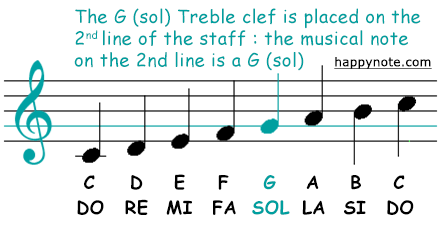
Watch the video below: in addition to understanding how the treble clef works, you will learn to read your first notes in just a few seconds!
Origin of the Treble Clef
While music specialists continue to debate its exact origin, it is generally accepted that it emerged somewhere between the 9th and 11th centuries in Western Europe.
Guido of Arezzo, an Italian Benedictine monk of the 11th century, is believed not only to have used the first syllables of each half-line of a Latin religious chant, the Ut queant laxis (the hymn to Saint John the Baptist), to establish the names of the notes, but also to have created the treble clef, which is thought to have its origins in a specific neume (a neume being a graphic symbol used in Gregorian chant to represent pitch).
Which Musical Instruments Use Sheet Music Written in the Treble Clef?
The notes of the treble clef are used to write sheet music for many musical instruments, whether they are keyboard, string, wind, or percussion instruments.
Keyboards:
- Piano
- Harpsichord
- Organ
- Celesta
- Synthesizer
Strings:
- Violin
- Cello
- Guitar
- Mandolin
- Harp
Woodwinds:
- Clarinet
- Oboe
- English horn
- Flute
- Saxophone
- Accordion
Brass:
- Trumpet
- Horn
Percussion:
- Glockenspiel
- Xylophone
- Marimba
- Vibraphone
- Tubular Bells
Singers
For singers, the treble clef is used with tenor, soprano, contralto, alto, and mezzo-soprano voices.
The Octave Treble Clef: Ottava Alta (8va)
On a musical score, the term 8va is an abbreviation of Ottava alta, an Italian term meaning that the notes should be played one octave – 8 notes – higher than written.
This notation makes reading the sheet music easier and avoids confusion caused by adding many extra lines to the staff.
Sometimes the score shows only the number 8, without the letters “va.”
In any case, the number 8 is placed above the treble clef, and dotted lines indicate the notes to be played one octave higher.
A particularly striking example of the use of ottava alta is the beginning of Franz Liszt’s 1st legend, St. Francis of Assisi’s sermon to the birds written in C major:
The Treble Clef on the 1st Line of the Staff
The treble clef on the first line is no longer used as a music clef today.
Present in France during the 17th and 18th centuries, it is called the French clef or even, in its English translation, the French violin clef.
The notes are identical to those of the bass clef on the 4th line, except that they are played two octaves higher.
Learn to Read Notes in the Treble Clef
The Happy Note! YouTube channel offers several videos to learn the treble clef, either with the alphabetical notation (A B C D E F G) or with the syllabic notation: Do Re Mi Fa Sol La Si, (fixed Do). and Do Re Mi Fa Sol La Ti (Norwich sol-fa system).
If you want to learn the treble clef with the alphabetical notation (A B C D E F G) used in English-speaking countries (USA, UK, etc.), you can also directly watch the video below:
Sheet Music Treble Clef and Bass Clef HN (Windows)
Learning to actually read notes while having fun is possible with the game Sheet Music Treble Clef and Bass Clef HN.
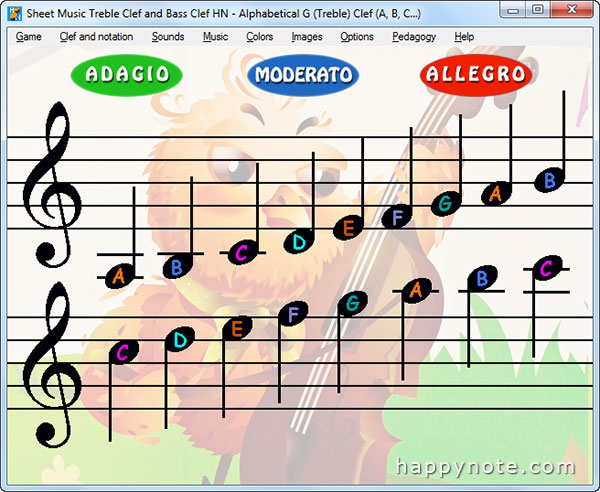
Tetris Music Notes HN (Windows)
Tetris Music Notes HN is a free educational music game where notes fall from the treble clef: you must guide them to their names while avoiding the dynamite sticks (optional) moving across your screen during the game!
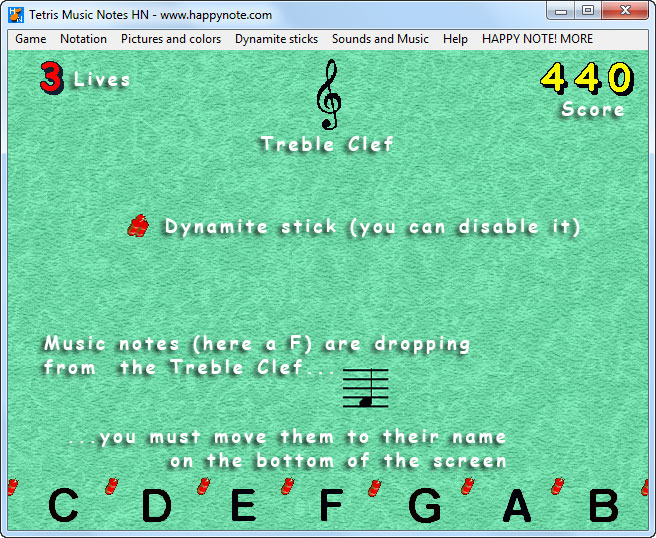
The Bass Clef (F Clef) on the 4th Line of the Staff
It’s the most commonly used music clef after the treble clef.
The bass clef is always drawn starting on the 4th line of the staff. Therefore, the note placed on the 4th line of the staff is an F (F3, slightly low).
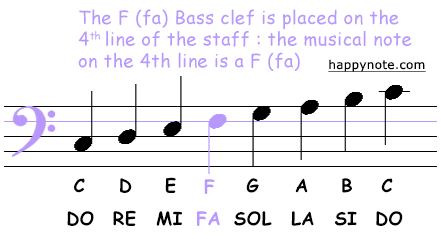
Watch the video below to understand the bass clef and learn to read F and C in less than 2 minutes.
Musical Instruments with Sheet Music Written in the Bass Clef
Keyboards:
- Piano
- Harpsichord
- Organ
- Celesta
- Synthesizer
Strings:
- Cello
- Double bass
- Guitar
- Bass guitar
- Harp
Brass:
- Trombone
- Euphonium / Tenor tuba
- Bass cornet / Bass trombone
- Baritone
- Tuba
Woodwinds:
- Bassoon
- Contrabassoon
- Bass clarinet
- Accordion
Percussion:
- Timpani
- Marimba
- Piano
- Bass drum
- Low xylophone
Singers
For singers, the bass clef on the fourth line is used for bass and baritone voices.
About Instruments Using Both Treble and Bass Clefs
For keyboard instruments, the upper staff, played by the right hand, is usually written in the treble clef, while the lower staff, played by the left hand, is mostly written in the bass clef.
This is the case, for example, with Beethoven’s famous Für Elise (video with sheet music in treble and bass clefs).
However, this is not always true. For example, at the beginning of Chopin’s famous Funeral March for piano, both hands play in the low register. That is why the composer added a bass clef just before the first notes of the upper staff. Thus, for the first five measures, both hands are written in the bass clef:
The Bass Clef with an Octave: Ottava Bassa (8ba)
Unlike the ottava alta, which is placed above the treble clef and indicates that the notes should be played one octave higher, the abbreviation 8ba is placed below the bass clef and indicates that the notes should be played one octave lower.
Learning to Read the Bass Clef on the 4th Line
The Happy Note! YouTube channel offers several videos to learn the treble clef, either with the alphabetical notation (A B C D E F G) or with the syllabic notation: Do Re Mi Fa Sol La Si, (fixed Do).
If you want to learn the bass clef with the alphabetical notation (A B C D E F G) used in English-speaking countries (USA, UK, etc.), you can also directly watch the video below:
If your computer runs Windows, the video game Sheet Music Treble Clef and Bass Clef HN provides a fun alternative to learn to read the bass clef (A B C and Do Re Mi).
The Bass Clef on the 3rd Line
Nowadays, the bass clef on the third line is used only for transposition.
The C Clef
The C clef can be placed on the 1st, 2nd, 3rd, or 4th line of the staff. This music clef is less common than the Treble and Bass clefs, and today, only the 3rd and 4th line forms are still used regularly.
Wherever it is placed, the line it centers on becomes middle C.
If it is placed on the first line of the staff, the note written on that line will be a C, the note in the first space will be a D, the note on the second line an E, and so on.
If the C clef is placed on the second line of the staff, then the note on that second line will be a C, and the names of the other notes of the scale will change accordingly.
The C Clef on the 1st Line
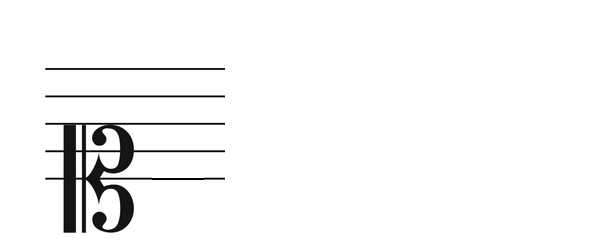
Called soprano clef, the C clef on the 1st line is now used only for orchestral transposition.
The C Clef on the 2nd Line

Called mezzo-soprano clef, the C clef on the 2nd line is used only by horn players.
The C Clef on the 3rd Line
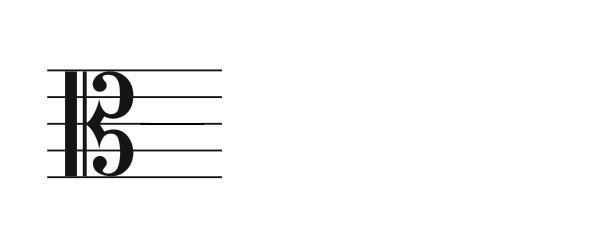
Called alto clef (or viola clef), the C clef placed on the 3rd line of the staff is used to write sheet music for:
- viola da gamba
- viola
- mandolin
- alto trombone
In the sheet music below, a viola, accompanied by a piano, plays The Swan by Saint-Saëns
The C Clef on the 4th Line
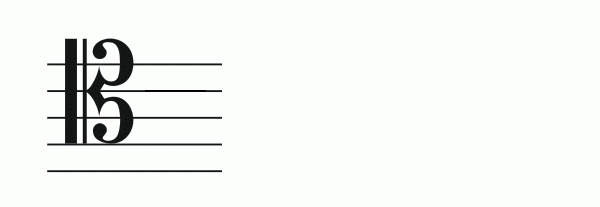
Called Tenor clef, the C clef on the 4th line of the staff is used to write sheet music for:
- bassoon
- cello
- tenor trombone
- euphonium
- double bass
- viola da gamba (rarely)
The C Clef on the 5th Line
Known as the baritone clef, it was once used to notate music for baritone voices, bassoons, or trombones, but had fallen out of use by the 18th or 19th century.
Is It Possible to Change Music Clefs During a Piece?
Yes, absolutely! See below the example of William Walton’s Passacaglia for cello, which alternates between the treble clef, the bass clef, and the C clef on the 4th line!
Special Music Clefs and Alternative Notations
Beyond the foundational G, F, and C clefs, other symbols exist to solve specific notational challenges. They are used, for example, to create parts for instruments without a definite pitch.
Percussion Clefs: Notation Beyond Pitch
The percussion clef, also known as the neutral clef, is designed for instruments that don’t produce specific pitches, such as a drum kit or cymbals. Its fundamental purpose is to change how the staff is read: instead of representing notes, each line and space is assigned to a different percussion instrument or articulation.

Visually, the clef is simple and functional, often appearing as just a rectangle or two parallel lines. This minimalist design reflects its role; unlike a G-clef or F-clef, it doesn’t anchor the staff to a reference pitch.
Because the clef carries no pitch information, it must be accompanied by a legend or key. This key provides the map for the performer, and it plays a unique role among music clefs by focusing entirely on rhythmic structure. It’s especially useful in drum set notation, ensemble percussion parts, or any context where pitch is irrelevant.
Tablature: An Alternative to the Music Clef
While traditional music clefs are the standard for most instruments, some musicians — especially guitarists — use tablature instead. Tablature (or “tab”) replaces the staff and clefs with a system that shows string and fret positions directly, making it easier for beginners to learn songs without reading standard notation.
However, tablature lacks some of the expressive information provided by clefs and standard notation — such as note duration and rhythm — which are essential for full musical interpretation.


